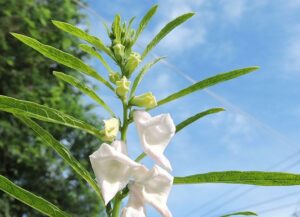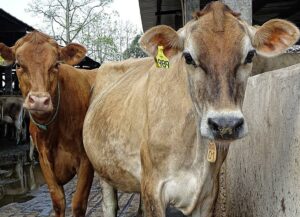Alvaro Garcia
The efficiency of pasture-based dairy systems is highly dependent on milk production per surface area. Another important component is daily production per cow and better yet, their lifetime production. A key input to accomplish this in these systems is feed quality, of which more than 80 percent can usually constitute grazed herbage, and the rest supplementation with concentrate.
While the quality of the concentrate can be maintained relatively consistent, the grazed forage nutrient concentration depends largely on the predominant plant species and the grazing management. Legumes and grasses and their blends can provide highly digestive feed that, if managed correctly, can even approximate the nutrient density of the concentrate.
Although legumes such as alfalfa and clover contribute significantly with digestible nutrients, grass species such as bromegrass, and particularly perennial ryegrass (Lolium Perenne L.) can enhance the quality of the pasture mix. When grazed at its immature stage, ryegrass can have a digestibility of more than 80% contributing a very similar amount of nutrients compared to concentrate.
The question then is if concentrate supplementation of grazed perennial ryegrass results in improvement in total feed intake and/or more nutrients available to the cow. To optimize its utilization, it is important to understand the dynamics of its digestion in the rumen and the passage of nutrients (e.g. amino acids) to the intestine. Since the protein in ryegrass is very digestible, most of its nitrogen will end up being incorporated into high quality microbial protein (provided there is also energy available) that ends up being utilized in the small intestine.
A recent study (Dineen et al. 2020) evaluated the effects of rolled barley grain supplementation on the pre-stomach microbial dynamics of lactating dairy cows fed fresh perennial ryegrass. It was speculated that the inclusion of barley would increase the fermentable carbohydrate to the rumen and thus increase the microbial N flow to the omasum compared to a ryegrass only diet.
Rumen cannulated Holstein cows averaging 49 ± 23 d in milk and 513 ± 36 kg of BW were assigned to 1 of 2 treatments (switchback design). The treatment diets were:
- Perennial ryegrass
- Perennial ryegrass plus 3.5 kg of dry matter (DM) of rolled barley
There were three 29-day periods with each consisting of 21 days of diet adaptation and 8 days for sampling and data collection. To determine the nutrient and microbial pool size, rumen evacuation techniques allowed for the calculation of fractional rates of digestion and microbial growth.
Protozoa and bacteria in lactating dairy cows
It is important to understand which microbial group (protozoa or bacteria) benefits the most from this supplementation and if in the end it enhances the nutrients delivered to the intestine. Protozoa for example have not been studied extensively although they do represent important nutrient contributors, particularly protein. Because of its high digestibility, cows eating perennial ryegrass have an accelerated rate of passage, which has been suggested to be crucial to the protozoa generation time. In addition, protozoa benefit from the rapid supply of sugars, soluble true protein, and moderate pH that occurs in cows grazing ryegrass.
Effect of barley grain supplementation
The results of this study showed no differences in daily milk yield or energy-corrected milk yield between both treatments. Milk fat concentration and milk urea nitrogen decreased, whereas milk protein concentration increased in cows fed the barley-supplemented ryegrass diet.
This could be explained because of highly digestible fiber affecting milk fat synthesis and greater nitrogen incorporated into microbial protein thus reducing blood urea and milk urea nitrogen. Similarly, a greater passage of microbial protein to the intestine would result in more amino acids absorbed and ultimately more milk protein synthesized.
An important observation was that the DM intake was higher in cows fed the ryegrass supplemented with rolled barley. Ruminal and total-tract fiber (NDF) digestibility was also lower in barley-supplemented cows, but there was no difference in the reticulorumen pH, which is interesting to note.
There were more fermentable carbohydrates in the rumen of barley-supplemented cows. The flow of true protein and bacterial N also increased in cows supplemented with barley. While protozoa N flow was the same between both diets, this group of microorganisms apparently supplied more microbial N and had shorter generation time.
Conclusion
This study demonstrated that cows eating perennial ryegrass depended greatly on the microbial synthesis as a source of true protein delivered to the small intestine. Supplementing perennial ryegrass with barley had no effect on cow performance, but it reduced NDF digestibility and increased bacterial N flow.
The decision or not of supplementing with barley will likely depend on the stocking rate and perennial ryegrass availability. If there is plenty of ryegrass pasture available, using rolled barley as a supplement likely results in an almost 1-1 substitution effect which will not end up in a greater supply of nutrients to the intestine. It is possible these results would differ if a grain with less fermentable starch like corn would have been used in this experiment.
Reference
M. Dineen, B. McCarthy, P. Dillon, P. A. LaPierre, S. Fessenden, C. Matthews, N. Galvin, and M. E. Van Amburgh. 2020. Rumen metabolism, omasal flow of nutrients, and microbial dynamics in lactating dairy cows fed fresh perennial ryegrass (Lolium perenne L.) not supplemented or supplemented with rolled barley grain. J. Dairy Sci. 103:11332–11348.
© 2020 Dairy Knowledge Center. All Rights Reserved.











